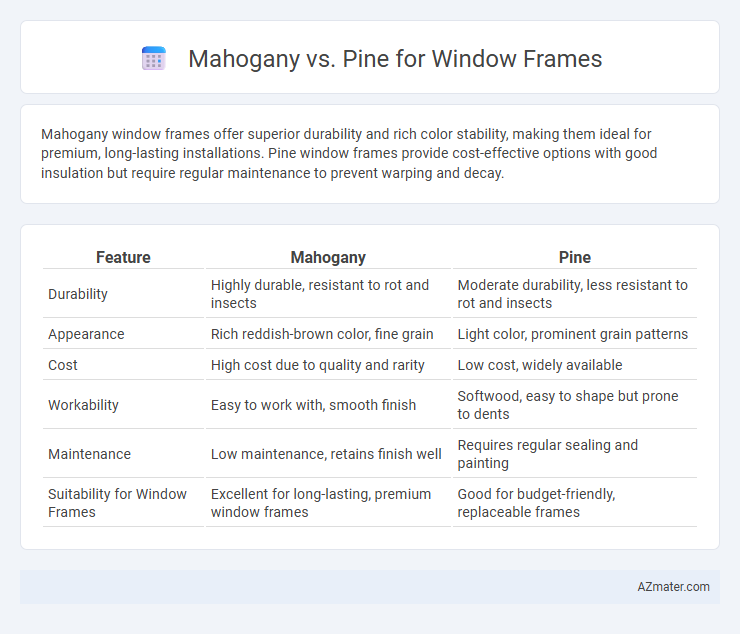Mahogany window frames offer superior durability and rich color stability, making them ideal for premium, long-lasting installations. Pine window frames provide cost-effective options with good insulation but require regular maintenance to prevent warping and decay.
Table of Comparison
| Feature | Mahogany | Pine |
|---|---|---|
| Durability | Highly durable, resistant to rot and insects | Moderate durability, less resistant to rot and insects |
| Appearance | Rich reddish-brown color, fine grain | Light color, prominent grain patterns |
| Cost | High cost due to quality and rarity | Low cost, widely available |
| Workability | Easy to work with, smooth finish | Softwood, easy to shape but prone to dents |
| Maintenance | Low maintenance, retains finish well | Requires regular sealing and painting |
| Suitability for Window Frames | Excellent for long-lasting, premium window frames | Good for budget-friendly, replaceable frames |
Introduction to Mahogany and Pine as Window Frame Materials
Mahogany is a dense, durable hardwood known for its rich reddish-brown color and natural resistance to rot and insects, making it a premium choice for window frames that require longevity and aesthetic appeal. Pine, a softwood with a pale yellow tone, is widely favored for its affordability and ease of customization, though it requires proper treatment to withstand moisture and insect damage. Both materials offer distinct advantages depending on budget, climate, and desired appearance for window framing applications.
Physical Characteristics: Mahogany vs Pine
Mahogany window frames are known for their dense, fine-grained texture, offering exceptional durability and resistance to rot and insect damage, making them ideal for long-lasting exterior use. Pine frames are lighter with a softer, more porous structure, resulting in easier workability but lower resistance to dents, scratches, and environmental wear over time. The natural oils in mahogany provide inherent moisture resistance, whereas pine requires additional treatment to withstand weather exposure.
Durability and Lifespan Comparison
Mahogany offers superior durability for window frames due to its dense hardwood structure, making it highly resistant to rot, insects, and weathering. Pine, being a softer wood, has a shorter lifespan and requires frequent maintenance to prevent warping and decay in outdoor environments. The longer lifespan of mahogany, often exceeding 50 years with proper care, contrasts sharply with pine's typical durability span of 15 to 20 years under similar conditions.
Appearance and Aesthetic Appeal
Mahogany window frames offer a rich, deep reddish-brown color with a fine, straight grain that exudes luxury and timeless elegance, making them ideal for high-end architectural designs. Pine frames feature a lighter, pale yellow to cream tone with noticeable knots and a more rustic, casual appearance suited for cozy, country-style interiors. The natural luster and smooth finish of mahogany enhance sophisticated aesthetics, while pine's versatility allows for easy staining or painting to match diverse decor themes.
Maintenance Requirements for Mahogany and Pine
Mahogany window frames demand minimal maintenance thanks to their natural resistance to rot and insect damage, requiring only occasional cleaning and refinishing to preserve their rich color and durability. Pine frames need more frequent upkeep, including regular sealing or painting to protect against moisture, warping, and pest infestation. Choosing mahogany reduces long-term maintenance costs and preserves aesthetic appeal better than pine in varied weather conditions.
Insulation and Energy Efficiency
Mahogany window frames offer superior insulation due to the wood's dense cellular structure, which reduces heat transfer and improves energy efficiency in homes. Pine frames, while more affordable, have a lower density and require more frequent sealing to maintain insulation properties and prevent drafts. Investing in mahogany window frames can lead to significant energy savings and enhanced thermal comfort over time.
Cost Analysis: Mahogany vs Pine
Mahogany window frames typically cost significantly more than pine due to the wood's durability, density, and rich aesthetic appeal, with prices averaging $30 to $50 per board foot compared to pine's $10 to $20 per board foot. Pine is favored for budget-friendly projects because of its affordability and widespread availability, although it generally requires more maintenance and faster replacement over time. When evaluating long-term cost efficiency, mahogany's resistance to decay and minimal upkeep can offset its higher initial investment compared to pine window frames.
Environmental Impact and Sustainability
Mahogany is a dense hardwood known for its durability and long lifespan, reducing the need for frequent replacements and minimizing waste. Pine, a fast-growing softwood, offers greater sustainability through quicker regeneration and lower carbon storage over its shorter lifecycle. Choosing pine window frames supports sustainable forestry practices, while mahogany frames provide enhanced longevity, making each option viable depending on environmental priorities.
Common Applications and Suitability
Mahogany is favored for window frames in high-end residential and commercial buildings due to its durability, resistance to rot, and rich aesthetic appeal, making it ideal for areas exposed to harsh weather conditions. Pine is commonly used in budget-friendly projects and interior window frames, offering ease of workability and a lighter finish but requiring proper treatment to enhance moisture resistance. Both woods are suitable for different climates and architectural styles, with mahogany preferred for long-lasting, premium applications and pine suited for economical, decorative purposes.
Summary: Which is Better for Window Frames?
Mahogany offers superior durability, resistance to rot, and a rich, elegant appearance ideal for long-lasting window frames in high-end homes. Pine is more affordable and easier to work with but is less durable, requiring regular maintenance and treatment to prevent decay and insect damage. For window frames requiring longevity and premium aesthetics, mahogany is the better choice; pine suits budget-friendly projects with routine upkeep.

Infographic: Mahogany vs Pine for Window Frame
 azmater.com
azmater.com